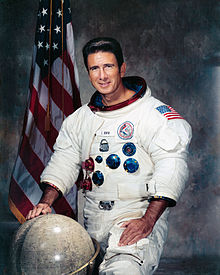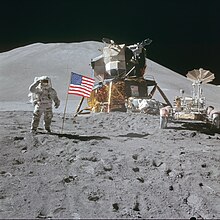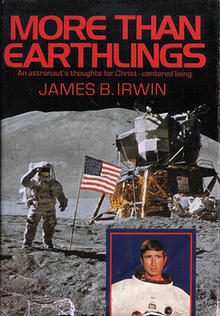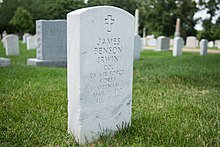| James Irwin | |
|---|---|
 Irwin in 1971 Irwin in 1971 | |
| Born | James Benson Irwin (1930-03-17)March 17, 1930 Pittsburgh, Pennsylvania, U.S. |
| Died | August 8, 1991(1991-08-08) (aged 61) Glenwood Springs, Colorado, U.S. |
| Resting place | Arlington National Cemetery |
| Education | |
| Spouse |
Mary Ellen Monroe (m. 1959) |
| Children | 5 |
| Awards | NASA Distinguished Service Medal |
| Space career | |
| NASA astronaut | |
| Rank | Colonel, USAF |
| Time in space | 12d 7h 12m |
| Selection | NASA Group 5 (1966) |
| Total EVAs | 4 3 EVAs on the moon 1 EVA stand-up |
| Total EVA time | 18h 35m |
| Missions | Apollo 15 |
| Mission insignia | |
| Retirement | July 31, 1972 |
James Benson Irwin (March 17, 1930 – August 8, 1991) was an American astronaut, aeronautical engineer, test pilot, and a United States Air Force pilot. He served as Lunar Module pilot for Apollo 15, the fourth human lunar landing. He was the 8th person to walk on the Moon.
Early life and education
Irwin was born March 17, 1930, in Pittsburgh, Pennsylvania, of Scottish, German (maternal side) and Irish descent, to parents James William Irwin (1896–1978), a U.S. Army World War I veteran, and Elsa Mathilda Irwin (née Strebel; 1898–1993) who had German ancestry. Irwin's paternal grandparents emigrated to the U.S. from Altmore Parish at Pomeroy in County Tyrone, Ireland (now Northern Ireland) around 1859.
At about the age of 12, he informed his mother about his desire to go to the Moon, letting her know that he might be the first person to do so (he ended up being the eighth). He graduated from East High School in Salt Lake City, Utah in 1947. He received a Bachelor of Science degree in naval science from the United States Naval Academy in 1951, and Master of Science degrees in aeronautical engineering and instrumentation engineering from the University of Michigan in 1957.
He received initial flight training at Hondo Air Base and follow-up training at Reese Air Force Base, Texas. He graduated from the Air Force Experimental Flight Test Pilot School (Class 60C) in 1961, and the Aerospace Research Pilot School in 1963 (Class IV). Prior to joining NASA, he was chief of the Advanced Requirements Branch at Headquarters Air Defense Command. During his time in the United States Air Force he received the Air Force Distinguished Service Medal and two Air Force Commendation Medals. He also received an Air Force Outstanding Unit Award while with the 4750th Training Wing.
Irwin was also a developmental test pilot for the Lockheed YF-12, the Mach 3 fighter-interceptor variant which preceded the SR-71 Blackbird. His first flight of that aircraft was on the day that one of his five children was born.
In 1961, a student pilot that Irwin was training crashed the plane they were flying on a training mission. They both survived, but Irwin suffered compound fractures, amnesia, and nearly lost a leg. John Forrest, a U.S. Air Force orthopedic surgeon, was instrumental in preventing the amputation of Irwin's leg.
During his military service, he accumulated more than 7,015 hours flying time, of which 5,300 hours were in jet aircraft.
Personal life
Irwin was raised in a Christian household but stopped actively practicing the religion at age 10. He became a devout born-again Christian after returning from space. He was a Young Earth Creationist.
In 1952, Irwin married his first wife, who was a Catholic. The two had an unhappy marriage made worse by his devotion to his work. By his own account, the marriage failed after two years due to his poor, borderline cruel treatment of her, and he later stated that finding religion again made familial relationships much easier.
In 1959, Irwin married his second wife, the former Mary Ellen Monroe (born 1938). They were married until his death.
Irwin had five children.
NASA career

Irwin was one of the 19 astronauts selected by NASA in April 1966. He was chosen as commander, with John S. Bull as lunar module pilot, for LTA-8, an environmental qualification test of the Apollo Lunar Module in a vacuum chamber at the Houston Space Environment Simulation Laboratory. He then served as a member of the astronaut support crew for Apollo 10, the first mission to carry the full Apollo stack to the Moon and the dry run for the first crewed Moon landing. Following that assignment, Irwin served as backup lunar module pilot for the second Moon landing mission, Apollo 12.
Apollo 15
Main articles: Apollo 15 and Return of Apollo 15 to Earth

Between July 26 and August 7, 1971 – as the Apollo 15 lunar module pilot (LMP) – Irwin logged 295 hours and 11 minutes in space. His extravehicular activity (EVA) on the Moon's surface amounted to 18 hours and 35 minutes of the mission time, an additional 33 minutes was used for Commander David R. Scott to do a stand-up EVA by opening the LM's docking hatch to survey the surroundings and take photographs. Irwin and David Scott's mission was more science-based than previous missions, which meant that they received intensive geological training to meet the demanding nature of the J-Mission profile. This extra training is credited with allowing them to make one of the most important discoveries of the Apollo era, the Genesis Rock.
Apollo 15 landed in the Moon's Hadley-Apennine region, noted for its mountains and rilles. As a J-Mission, they would spend more time on the Moon than previous missions, to allow for three EVAs. As well, Irwin was the first automobile passenger on the Moon as Scott drove the Lunar Roving Vehicle (LRV) carried along for this mission in the lunar module (LM) Falcon's Descent Stage. Scott and Irwin's stay on the Moon was just under three days at 66 hours and 54 minutes.
Once the rendezvous procedure was completed between Falcon and the Endeavour CSM, Irwin and Scott were busy moving items like rock samples into the CSM and preparing the lunar module for final separation. During this intense period of work the earliest symptoms of a heart condition appeared. Both Scott and Irwin had been working with no sleep for 23 hours, during which they conducted a final moonwalk, performed the ascent from the lunar surface, rendezvoused with Endeavour, and encountered the problems that delayed the lunar module jettison maneuver. The astronauts' physiological vital signs were being monitored back on Earth, and the flight surgeons noticed some irregularities in Irwin's heart rhythms. Irwin's heart had developed bigeminy. Charles Berry stated to Chris Kraft, deputy director of the Manned Spacecraft Center (MSC) at the time: "It's serious, f he were on Earth. I'd have him in ICU being treated for a heart attack." However, Berry concluded that since Endeavour's cabin atmosphere was 100% oxygen when in space, Irwin was in the best of circumstances. Specifically, "In truth, ... he's in an ICU. He's getting one hundred percent oxygen, he's being continuously monitored, and best of all, he's in zero g. Whatever strain his heart is under, well, we can't do better than zero g."
During the post-trans-Earth injection (TEI) phase of the mission there wasn't much more for Irwin to do other than provide help with Al Worden's EVA to retrieve film magazines from the CSM's SIM bay, by donning a pressure suit and monitoring him. He was able to rest and apparently recover during the rest of the mission. The flight surgeons continued to monitor his EKG until splashdown, but his heart rhythm was normal. This incident was not discussed during the mission debriefing sessions, and the condition did not appear when he returned to Earth.
Post-NASA career
See also: Apollo 15 postal covers incident
After the return of Apollo 15 to Earth, it was discovered that without authority the crew had taken 398 commemorative first day covers to the Moon of which a hundred were then sold to a German stamp dealer. The profits of the sale were intended to be used to establish trust funds for the children of Apollo 15's crew. NASA had turned a blind eye to similar activities on earlier flights, but on this occasion the administration reprimanded the astronauts, and they never received any funds from the sales. Irwin had announced his intent to retire from the Air Force and resign from NASA prior to the reprimand. During a subsequent investigations by NASA, the Attorney General, and Congress, the astronauts surrendered the covers still in their possession; they were returned in 1983. Slate magazine opined that the action effectively exonerated the astronauts.
Irwin, describing his experience during the Apollo 15 lunar mission.I felt the power of God as I'd never felt it before.
By his own admission, Irwin was not a committed Christian during his years at NASA. After his retirement as a colonel in 1972, Irwin founded the High Flight Foundation. He spent the next 20 years as a "Goodwill Ambassador for the Prince of Peace", stating that "Jesus walking on the earth is more important than man walking on the moon". He said that his experiences in space had made God more real to him than before. Irwin and his wife stated that his Christian rebirth, which happened while he was in space, saved their marriage and made their lives much happier.
Beginning in 1973, Irwin led several expeditions to Mount Ararat, Turkey, in search of the remains of Noah's Ark. In 1982, he was injured during the descent and had to be transported down the mountain on horseback. In More Than Earthlings, Irwin wrote expressing his view that the Genesis creation narrative was real, literal history.
Death

Irwin suffered three major heart attacks. One occurred less than two years after Apollo 15, when Irwin was 43, while he was playing handball; he underwent an emergency triple bypass operation. Two months later he suffered a subsequent heart attack while skiing in Colorado. Irwin suffered another heart attack on June 6, 1986, when he collapsed during a run and was found pulseless on a curb. Doctors from NASA doubted the incidents were related to space travel, and noted that pre-flight testing indicated him having a tendency for cardiac arrhythmias during strenuous exercise.
On August 8, 1991, Irwin suffered another heart attack after a bicycle ride. Attempts at resuscitation were unsuccessful, and Irwin died later that day. He was buried at Arlington National Cemetery. He and his wife, Mary Ellen, to whom he was married for three decades, had five children.
Of the 12 men who have walked on the Moon, Irwin was the first to die. The James Irwin Charter Schools were founded in Colorado in his honor.
A patch cut by Irwin from a backpack abandoned on the Moon during the Apollo 15 mission was auctioned at Christie's in 2001 for $310,500 in a consignment of material from Irwin's estate that garnered "a combined $500,000".
Organizations
Irwin was a member of the Air Force Association and the Society of Experimental Test Pilots. He was also a Freemason, initiated in Tejon Lodge No. 104 in Colorado Springs. He was the third Freemason to set foot on the Moon, after Buzz Aldrin and Edgar Mitchell.
Irwin was a member of Civitan International, a nonprofit organization promoting community service, scientific research, and service to people with intellectual and developmental disabilities.
Awards and honors
- Command Pilot Astronaut Wings
- Air Force Distinguished Service Medal
- two Air Force Commendation Medals
- NASA Distinguished Service Medal
- United Nations Peace Medal, 1971
- City of New York Gold Medal, 1971
- City of Chicago Gold Medal, 1971
- Air Force Association's David C. Schilling Trophy, 1971
- Robert J. Collier Trophy, 1971
- Haley Astronautics Award (American Institute of Aeronautics and Astronautics), 1972
- Arnold Air Society's John F. Kennedy Trophy, 1972
Irwin's other awards include: Belgium's Order of Leopold in 1971; Kitty Hawk Memorial Award, 1971; New York Police Department St. George Association's Golden Rule Award in 1972; Christian Service Award; Milan Hulbert Trophy of SWAP International in 1973.
He was also awarded an Honorary Doctorate of Astronautical Engineering from the University of Michigan in 1971; an Honorary Doctorate of Science from the William Jewell College in 1971; and an Honorary D.Sc. from the Samford University in 1972.
He was inducted into the International Space Hall of Fame in 1983, and posthumously into the U.S. Astronaut Hall of Fame, on October 4, 1997.
In 1973, When Irwin visited the city of Minden, Louisiana, to address a gathering at the First Baptist Church, Mayor Tom Colten declared "James Irwin Day" and made Irwin an "honorary citizen of Minden."
In media
In the 1998 HBO miniseries From the Earth to the Moon Irwin was played by Gareth Williams.
Bibliography
- To Rule the Night: The Discovery Voyage of Astronaut Jim Irwin (with William A. Emerson, Jr., 1973)
- More Than Earthlings (1983)
- More Than an Ark on Ararat: Spiritual Lessons Learned While Searching for Noah's Ark (with Monte Unger, 1985)
- Destination: Moon (1989)
- Flight Of The Falcon: The Thrilling Adventures Of Colonel Jim Irwin (1991)
See also
References
- ^ Reynolds, David West (2002). Apollo: The Epic Journey to the Moon. Tehabi Books. pp. 166–189. ISBN 0-15-100964-3.
- ^ "Astronaut-turned-evangelist dies of heart attack". Eugene Register-Guard. (Oregon). Associated Press. August 10, 1991. p. 7A.
- "A Who's Who on Apollo Crew". Daily News. New York, New York. July 26, 1971. p. 12 – via Newspapers.com.
- Allen, Sam (1985) . To Ulster's Credit. Killinchy, UK. p. 123.
{{cite book}}: CS1 maint: location missing publisher (link) - Interview with Jim Irwin's parents after his selection to NASA (1966, published at YouTube on January 17, 2018)
- ^ "Biographical Data: James Irwin" (PDF). National Aeronautics and Space Administration. August 1991. Retrieved April 2, 2021.
- "Living With an American Hero | Latest Space News". Echoesofapollo.com. Archived from the original on August 10, 2011. Retrieved April 23, 2015.
- ^ Flight of the Falcon: The Thrilling Adventures of Colonel Jim Irwin
- "From Ike to athletes to Elmirans, surgeon touched many". Star Gazette. September 18, 2015. Retrieved December 10, 2017.
- Wilford, John Noble (August 10, 1991). "James B. Irwin, 61, Ex-Astronaut; Founded Religious Organization". The New York Times.
- "James Benson Irwin".
- Thompson, Ronald (April 5, 1966). "19 New Spacemen Are Named". The High Point Enterprise. High Point, North Carolina. p. 2A – via Newspapers.com.
- "The Moon-Walker's New Clothes" (PDF). NASA. January 19, 1968. Retrieved December 10, 2017.
- ^ "International Space Hall of Fame :: New Mexico Museum of Space History :: Inductee Profile". Nmspacemuseum.org. Retrieved April 23, 2015.
- ^ Woods, David (September 14, 2006). "Mountains of the Moon". Apollo 15 Lunar Surface Journal. NASA. Archived from the original on January 17, 2012. Retrieved February 15, 2007.
- ^ Chaikin, Andrew (1998) . A Man on the Moon. Toronto: Penguin Books. ISBN 0-14-027201-1.
- ^ Woods, David (May 28, 2004). "Apollo 15 Flight Summary". Apollo Flight Journal. National Aeronautic and Space Administration. Archived from the original on March 24, 2007. Retrieved February 15, 2007.
- ^ Kraft, Chris; Schefter, James L. (March 2001). Flight: My life in Mission Control. New York: Penguin Group. pp. 342–34. ISBN 0-525-94571-7.
- "Apollo 15 Technical Crew Debriefing" (PDF). NASA. August 14, 1971. Archived from the original (PDF) on January 26, 2017. Retrieved December 10, 2017.
- Worden, Al (July 2011). Falling to Earth: An Apollo 15 Astronaut's Journey to the Moon. Smithsonian Institution Press. ISBN 978-1588343093.
- ^ Wilford, John Noble (August 10, 1991). "James B. Irwin, 61, Ex-Astronaut; Founded Religious Organization". The New York Times. Retrieved September 17, 2016.
- "U.S. Returns Stamps to Former Astronauts". The New York Times. Associated Press. July 30, 1983. p. 11. Archived from the original on June 22, 2018. Retrieved December 21, 2018.
- Powell, Corey S.; Shapiro, Laurie Gwen (December 16, 2013). "The Bizarre, Tangled Tale of the Only Sculpture on the Moon". Slate Magazine. Retrieved April 29, 2019.
- "Colonel James B. Irwin – About Us & Board". Highflightfoundation.org. Archived from the original on December 11, 2017. Retrieved April 23, 2015.
- Irwin, Mary; Harris, Madalene (1978). The Moon is Not Enough. Zondervan Publishing House. ISBN 9780310370505. OCLC 3845054.
- Howe, Marvine (September 18, 1983). "Rush To Climb Ararat Gives Town A Lift". The New York Times. Retrieved September 17, 2016.
- Bergman, Jerry (2013). "Colonel James Irwin: Creationist Astronaut". Institute for Creation Research (from Acts & Facts. 42 (11)). Retrieved August 2, 2016.
- Irwin, James B. (July 1983). More Than Earthlings: An Astronaut's Thoughts for Christ-Centered Living. Baptist Sunday School Board. ISBN 978-0805452556.
- "Ex-Astronaut Apparently Has Heart Attack While Jogging". The New York Times. June 8, 1986. Retrieved September 17, 2016.
- Arlington National Cemetery
- "James Irwin Charter Schools". James Irwin Charter Schools. Retrieved April 14, 2024.
- "Irwin backpack patch sale". Antiques Roadshow Insider. 7 (2): 11. February 2007.
- "Masonic Astronauts". Freemason Information. March 2015. Retrieved August 20, 2018.
- "Freemasons in Space". Grand Lodge of British Columbia and Yukon. Retrieved August 20, 2018.
- "Civitan International Clergy Week" (PDF). Gerald R. Ford Presidential Library. 1974. p. 4. Retrieved January 29, 2023.
- Sheppard, David (October 2, 1983). "Space Hall Inducts 14 Apollo Program Astronauts". El Paso Times. El Paso, Texas. p. 18 – via Newspapers.com.
- "James B. Irwin | Astronaut Scholarship Foundation". Astronautscholarship.org. Retrieved April 23, 2015.
- Meyer, Marilyn (October 2, 1997). "Ceremony to Honor Astronauts". Florida Today. Cocoa, Florida. p. 2B – via Newspapers.com.
- Pop McDonald, "Mayor Makes Col. James Irwin an 'Honorary Citizen of Minden,'" Minden Press-Herald, February 26, 1973, p. 1.
- "From the Earth to the Moon, Full Cast and Crew". IMDb. Retrieved December 4, 2017.
External links
- James Irwin at IMDb
- James Irwin at Encyclopedia Astronautica
- Institute of Creation Research biography of James Irwin
- Irwin at Encyclopedia of Science
- Arlington National Cemetery biography and photos
- High Flight Foundation
- ANC Explorer
| NASA Astronaut Group 5, "The Original 19", 1966 | |||||||
|---|---|---|---|---|---|---|---|
| NASA Astronaut Group 4 ← NASA Astronaut Group 5 → NASA Astronaut Group 6 | |||||||
| |||||||
- James Irwin
- 1930 births
- American people of German descent
- 1991 deaths
- 1971 in spaceflight
- 20th-century American businesspeople
- 20th-century American engineers
- American aerospace engineers
- American test pilots
- American people of Scotch-Irish descent
- American Christians
- American Christian Young Earth creationists
- American people of Irish descent
- American people of Scottish descent
- Apollo 15
- Apollo program astronauts
- Burials at Arlington National Cemetery
- Collier Trophy recipients
- Military personnel from Pittsburgh
- Mount Ararat
- People who have walked on the Moon
- 20th-century American explorers
- Recipients of the Air Force Distinguished Service Medal
- Recipients of the NASA Distinguished Service Medal
- Spacewalkers
- United States Air Force astronauts
- United States Air Force officers
- United States Naval Academy alumni
- United States Astronaut Hall of Fame inductees
- University of Michigan College of Engineering alumni
- U.S. Air Force Test Pilot School alumni
- American creationists